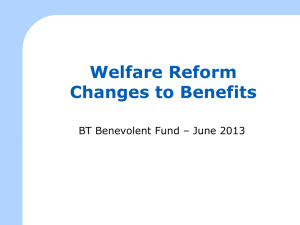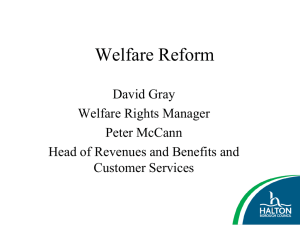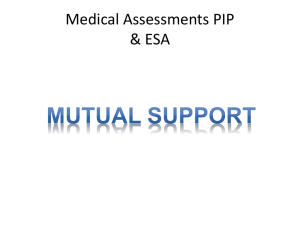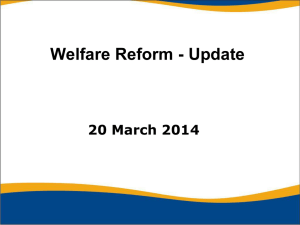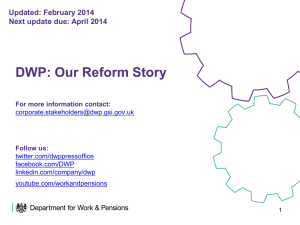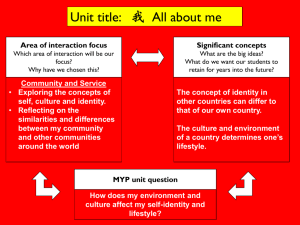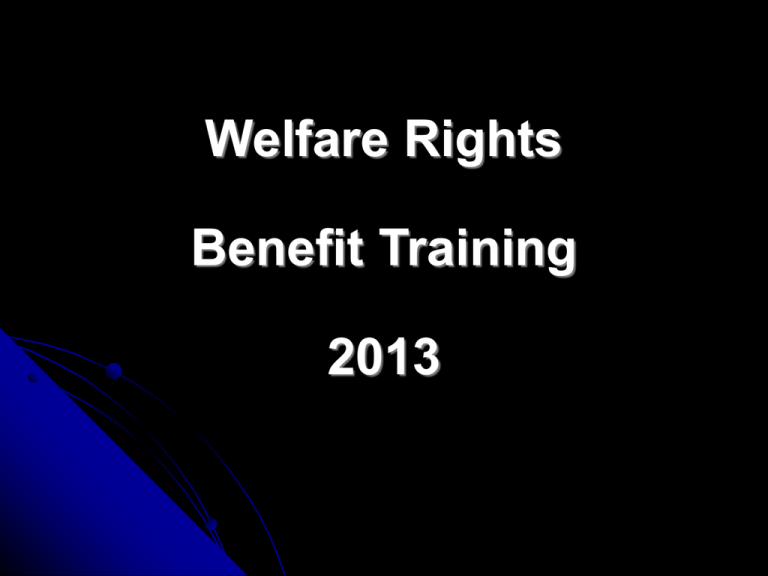
Welfare Rights
Benefit Training
2013
DISABILITY LIVING
ALLOWANCE (DLA)
CHANGES TO
PERSONAL INDEPENDENCE
PAYMENT (PIP)
What is PIP?
The personal independence payment (PIP) replaces working
age Disability Living Allowance (DLA) from 8 April 2013. The
change applies across the UK.
What are the rules for PIP?
To get the personal independence payment you must:
Be age 16 - 64
Satisfy the daily living and/or mobility activities test for 3 months
prior to claiming and be likely to continue to satisfy this test for a
period of at least 9 months after claiming.
Residence and presence tests
In order to claim personal independence normally you
must:
Have been present in Great Britain for 104 weeks out of the
156 weeks before claiming (2 out of the last 3 years) and
be habitually resident
You will not be able to claim PIP once you are 65 years old but
you will be able to stay on PIP if you claimed or received it
before you reached the age of 65.
If you are over 65 and become disabled for the first time you can
still claim Attendance Allowance
You can receive PIP whether you are in or out of work.
12.
In order to qualify for PIP you will have to score a certain
number of points in relation to 12 activities. These are:
1 Preparing food.
2 Taking nutrition.
3 Managing therapy or monitoring a health condition
4 Washing and bathing.
5 Managing toilet needs or incontinence.
6 Dressing and undressing.
7 Communicating verbally.
8 Reading and understanding signs, symbols and words.
9 Engaging with other people face to face.
10 Making budgeting decisions.
11 Planning and following journeys. (Used in the test for
the mobility component)
12 Moving around. (Used in the test for the mobility
component)
Each activity 1 – 12 above has a set of descriptors.
Points are awarded for each activity that you cannot
do based on whether you fit a descriptor within those
activities.
You can score points for more than one activity but If
more than one descriptor applies in any activity you
will be awarded whichever descriptor gives you the
most points.
If you can show that a descriptor applies to you for 6
months within a 12 month period you will be awarded
the appropriate points.
How will the activities tests be applied?
In most cases you will be asked to attend a face-toface consultation with an independent healthcare
professional (HCP).
At the consultation the HCP looks at your ability to
carry out the PIP activities.
The HCP will look at your claim form and any medical
evidence from your GP or consultant, if you have one.
You will be able to take someone with you to the
consultation such as a family member or carer.
Following the consultation the HCP will advise a
benefit decision maker at the Department for Work
and Pensions who will be the one who actually
decides if you are entitled to PIP and which
component applies if any.
The decision maker will also decide the length of
your award and the date when it will be reviewed,
based on the likelihood of your health condition or
impairment changing.
Depending on your circumstances you may get a short award of
up to 2 years or a longer award lasting up to 5 or 10 years.
If you are given a longer award you may still be contacted,
during this time, to see if your needs have changed.
Two organisations are responsible for carrying out consultations.
Atos IT Services will carry out assessments in London, Southern
England, the North East, the North West England and Scotland
Atos will be working in partnership with NHS Lanarkshire,
private hospitals and national networks of locally-based health
professionals, such as physiotherapists, using their premises to
undertake face-to-face consultations.
Capita Business Services Ltd will carry out assessments in
Central England, Wales and Northern Ireland
2.
How much is PIP?
The weekly amounts of PIP are:
Daily living component
Standard rate – If you have a limited ability to carry
out daily living activities - £53.00
Enhanced rate – If you have a severely limited ability
to carry out daily living activities - £79.15
Mobility component
Standard rate – If you have limited mobility - £21.00
Enhanced rate - If you have severely limited mobility
- £55.25
The entitlement thresholds (pass mark) for the
rates and components of the PIP are:
Daily Living component (activities 1 to 10)
Standard rate £53 weekly: 8+ points
Enhanced rate £79.15 weekly: 12+ points
Mobility component (activities 11 to 12)
Standard rate £21 weekly: 8+ points
Enhanced rate £55.25 weekly: 12+ points
DS1500 cases
If you have a terminal illness (that is if you are
suffering from a progressive disease where death
can be expected within 6 months) you will
automatically receive the daily living component
enhanced rate £79.15 weekly.
If you are terminally ill you only have to be present
in the UK at the date of claim with no waiting
period either
You will also be able to apply for the mobility
component and receive it immediately if you
qualify.
As with DLA PIP will stop if you have been in
hospital for over 28 days
If you are in a care home you will be entitled to the
mobility component so long as you satisfy the
qualifying conditions.
If you are paid PIP you are free to spend the
money in the way that suits you best.
PIP 'delivery timetable' is From 8 April 2013:
New claims for PIP will be taken in a 'controlled
start area' in the North West and part of the
North East of England.
Postcodes affected are: BL, CA, CH (except
CH5, CH6, CH7 and CH8), CW, DH, DL
(except DL6, DL7, DL8, DL9, DL10 and DL11),
FY, L, LA (except LA27, LA28, LA62 and LA63),
M, NE, PR, SR, TS (except TS9), WA and WN.
From June 2013:
New claims for PIP will be taken in
all remaining areas of Great Britain.
I would expect a massive take up
campaign locally now to get as
many people onto DLA before its
abolished for new claims from June
2013?
From October 2013:
Reassessment for PIP begins for existing
Disability Living Allowance (DLA)
claimants reporting a change in their
condition
The DWP will also start contacting those
reaching the end of fixed period DLA
awards and young people turning 16
years of age.
From October 2015:
All remaining claimants already in
receipt of a DLA award will be invited to
make a claim for PIP.
DWP will randomly select those
recipients of DLA in receipt of an
indefinite award or a fixed term award
and notify them about what they need
to do to claim PIP.
The DWP will prioritise existing DLA recipients who
have turned 65 after 8 April 2013, when PIP was
first introduced.
DLA will remain in payment for all claimants until a
decision on PIP has been communicated to the
claimant.
10,370 claimants of DLA in D&G
who are under 65
DWP say no Employment
Support Allowance medical
evidence will be used to assess
PIP claims
428,000 fewer working-age
disabled people will qualify for
the higher mobility PIP rate
(which allows access to the
Motability scheme) by 2018
Claimants have to be unable to walk for 20m
unaided. Previously, the distance was 50m.
There could be 160,000 fewer Motability
cars on the road by 2018.
A loss of 5,692 car industry related jobs
Distance, time, speed and manner of
walking removed for now
People’s ability to undertake tasks
‘reliably, repeatedly, safely and in a
timely manner’ into the regulations for
PIP, which will ensure both
assessments and appeal hearings
consistently take account of factors
such as pain, fatigue, breathlessness
and other symptoms generated by
undertaking tasks.
The claim process (new claims)
Step 1:
Claims can be made by calling DWP on an 0800 number.
Paper claim forms will be by exception for those claimants
that are unable to make a claim by phone.
The initial information required to make a claim for PIP will
be basic information covering:
The claimant’s personal and contact details
Residency details (known as residency and presence)
Relevant periods spent in hospital, residential care
Claims under special rules for terminally ill people, and
Payment (bank account) details
Step 2:
A ‘How your disability affects you’ form
is then posted to the claimant.
This allows the claimant to explain how
their condition affects them in their own
words.
It is individually addressed and
barcoded to speed up processing when
it is returned and only usable by them.
Any additional evidence that
may help and support the claim
can be returned with this form.
The form and any supporting
evidence is returned to DWP in
a freepost envelope.
Step 3: The Assessment
The claim information, completed form and any
additional evidence is passed over to a health
professional.
Step 4: The health professional will decide if there is a
need for any further evidence and will make all the
arrangements to get this.
Some assessments may be completed at this stage,
such as if someone is claiming under the special rules
for the terminally ill or where the written evidence is
sufficient.
Most will be asked to attend a face-to-face
consultation.
The points scoring system
Daily Living component (activities 1 to 10)
Standard rate £53 weekly: 8+ points
Enhanced rate £79.15 weekly: 12+ points
DAILY LIVING ACTIVITIES
1. Preparing food.
a. Can prepare and cook a simple meal unaided. 0 points.
b. Needs to use an aid or appliance to be able to either prepare
or cook a simple meal. 2 points.
c. Cannot cook a simple meal using a conventional cooker but is
able to do so using a microwave. 2 points
d. Needs prompting to be able to either prepare or cook a simple
meal. 2 points.
e. Needs supervision or assistance to either prepare or cook a
simple meal. 4 points.
f. Cannot prepare and cook food. 8 points.
2.
Taking nutrition.
a
Can take nutrition unaided. 0 points.
b
Needs –
(i) to use an aid or appliance to be able to take nutrition; or
(ii) supervision to be able to take nutrition; or
(iii) assistance to be able to cut up food. 2 points.
c
Needs a therapeutic source to be able to take nutrition. 2
points.
d
Needs prompting to be able to take nutrition. 4 points.
e
Needs assistance to be able to manage a therapeutic
source to take nutrition. 6 points.
f
Cannot convey food and drink to their mouth and needs
another person to do so. 10 points.
3. Managing therapy or monitoring a health condition.
a. Either –
(i) does not receive medication or therapy or need to
monitor a health condition; or
(ii) can manage medication or therapy or monitor a health
condition unaided. 0 points.
b. Needs either –
(i) to use an aid or appliance to be able to manage
medication; or
(ii) supervision, prompting or assistance to be able to
manage medication or monitor a health condition. 1 point.
c. Needs supervision, prompting or assistance to be able to
manage therapy that takes no more than 3.5 hours a week.
2 points.
3. Managing therapy or monitoring a health
condition continued
d. Needs supervision, prompting or assistance to
be able to manage therapy that takes more than
3.5 but no more than 7 hours a week. 4 points.
e. Needs supervision, prompting or assistance to
be able to manage therapy that takes more than 7
but no more than 14 hours a week. 6 points.
f. Needs supervision, prompting or assistance to
be able to manage therapy that takes more than
14 hours a week. 8 points.
4. Washing and bathing.
a. Can wash and bathe unaided. 0 points.
b. Needs to use an aid or appliance to be able to wash or bathe. 2
points.
c. Needs supervision or prompting to be able to wash or bathe. 2
points.
d. Needs assistance to be able to wash either their hair or body below
the waist. 2 points.
e. Needs assistance to be able to get in or out of a bath or shower. 3
points.
f. Needs assistance to be able to wash their body between the
shoulders and waist. 4 points.
g. Cannot wash and bathe at all and needs another person to wash
their entire body. 8 points.
5. Managing toilet needs or incontinence.
a. Can manage toilet needs or incontinence unaided. 0 points.
b. Needs to use an aid or appliance to be able to manage toilet
needs or incontinence. 2 points.
c. Needs supervision or prompting to be able to manage toilet
needs. 2 points.
d. Needs assistance to be able to manage toilet needs. 4 points.
e. Needs assistance to be able to manage incontinence of either
bladder or bowel. 6 points.
f. Needs assistance to be able to manage incontinence of both
bladder and bowel. 8 points.
6. Dressing and undressing.
a. Can dress and undress unaided. 0 points.
b. Needs to use an aid or appliance to be able to dress or
undress. 2 points.
c. Needs either (i) prompting to be able to dress, undress or determine
appropriate circumstances for remaining clothed; or
(ii) prompting or assistance to be able to select appropriate
clothing. 2 points.
d. Needs assistance to be able to dress or undress their lower
body. 2 points.
e. Needs assistance to be able to dress or undress their upper
body. 4 points.
f. Cannot dress or undress at all. 8 points.
7. Communicating verbally.
a. Can express and understand verbal information
unaided. 0 points.
b. Needs to use an aid or appliance to be able to speak
or hear. 2 points.
c. Needs communication support to be able to express or
understand complex verbal information. 4 points.
d. Needs communication support to be able to express
or understand basic verbal information. 8 points.
e. Cannot express or understand verbal information at all
even with communication support. 12 points.
8. Reading and understanding signs, symbols and words.
a. Can read and understand basic and complex written
information either unaided or using spectacles or contact
lenses. 0 points.
b. Needs to use an aid or appliance, other than spectacles or
contact lenses, to be able to read or understand either basic
or complex written information. 2 points.
c. Needs prompting to be able to read or understand complex
written information. 2 points.
d. Needs prompting to be able to read or understand basic
written information. 4 points.
e. Cannot read or understand signs, symbols or words at all. 8
points.
9. Engaging with other people face to face.
a. Can engage with other people unaided. 0 points.
b. Needs prompting to be able to engage with other
people. 2 points.
c. Needs social support to be able to engage with other
people. 4 points.
d. Cannot engage with other people due to such
engagement causing either –
(i) overwhelming psychological distress to the claimant;
or
(ii) the claimant to exhibit behaviour which would result in
a substantial risk of harm to the claimant or another
person. 8 points.
10. Making budgeting decisions.
a. Can manage complex budgeting decisions
unaided. 0 points.
b. Needs prompting or assistance to be able to
make complex budgeting decisions. 2 points.
c. Needs prompting or assistance to be able to
make simple budgeting decisions. 4 points.
d. Cannot make any budgeting decisions at all.
6 points.
The points scoring system
Mobility component (activities 11 to 12)
Standard rate £21 weekly: 8+ points
Enhanced rate £55.25 weekly: 12+ points
MOBILITY ACTIVITIES
11. Planning and following journeys.
a. Can plan and follow the route of a journey
unaided. 0 points.
b. Needs prompting to be able to undertake any
journey to avoid overwhelming psychological
distress to the claimant. 4 points.
c. Cannot plan the route of a journey. 8 points.
MOBILITY ACTIVITIES Continued
d. Cannot follow the route of an unfamiliar journey
without another person, assistance dog or
orientation aid. 10 points.
e. Cannot undertake any journey because it would
cause overwhelming psychological distress to the
claimant. 10 points.
f. Cannot follow the route of a familiar journey
without another person, an assistance dog or an
orientation aid. 12 points.
12. Moving around.
a. Can stand and then move more than 200
metres, either aided or unaided. 0 points.
b. Can stand and then move more than 50
metres but no more than 200 metres, either
aided or unaided. 4 points.
c. Can stand and then move unaided more
than 20 metres but no more than 50 metres.
8 points.
12. Moving around continued
d. Can stand and then move using an aid or
appliance more than 20 metres but no more than
50 metres. 10 points.
e. Can stand and then move more than 1 metre
but no more than 20 metres, either aided or
unaided. 12 points.
f. Cannot, either aided or unaided, –
(i) stand; or
(ii) move more than 1 metre. 12 points.
Reliably, in a timely fashion, repeatedly
and safely
An individual must be able to complete an
activity descriptor reliably, in a timely
fashion, repeatedly and safely; and where
indicated, using aids and appliances or with
support from another person (or, for activity
10, a support dog).
Otherwise they should be considered unable
to complete the activity described at that
level.
Reliably means to a reasonable standard.
In a timely fashion means in less than twice the time
it would take for an individual without any impairment.
Repeatedly means completed as often during the day
as the individual activity requires. Consideration needs
to be given to the cumulative effects of symptoms such
as pain and fatigue – i.e. whether completing the
activity adversely affects the individual’s ability to
subsequently complete other activities.
Safely means in a fashion that is unlikely to cause
harm to the individual, either directly or through
vulnerability to the actions of others; or to another
person.
Risk and Safety
When considering whether an activity can be
undertaken safely it is important to consider the
risk of a serious adverse event occurring.
However, the risk that a serious adverse event
may occur due to impairments is insufficient –
there has to be evidence that if the activity was
undertaken, the adverse event is likely to occur.
Aids and appliances
The assessment will take some account of aids and
appliances which are used in everyday life. In this context:
Aids are devices that help a performance of a function, for
example, walking sticks or spectacles.
Appliances are devices that provide or replace a
missing function, for example artificial limbs,
collecting devices (stomas) and wheelchairs.
The assessment will take into account aids and
appliances that individuals normally use and low
cost, commonly available ones which someone
with their impairment might reasonably be
expected to use, even if not normally used.
Individuals who use or could reasonably be
expected to use aids to carry out an activity will
generally receive a higher scoring descriptor than
those who can carry out the activity unaided.
Support dogs
We recognise that guide, hearing and dual sensory dogs
are not ‘aids’ but have attempted to ensure that the
descriptors capture the additional barriers and costs of
needing such a dog where they are required to enable
individuals to follow a journey safely.
Support from other people
The assessment will take into account where individuals
need the support of another person or persons to carry
out an activity – including where that person has to carry
out the activity for them in its entirety. The criteria refer to
three types of support:
Assistance is support that requires the presence
and physical intervention of another person i.e.
actually doing some or all of the task in question.
This specifically excludes non-physical
intervention such as prompting or supervision
which are defined below. To apply, this only
needs to be required for part of the activity.
Prompting is support provided by reminding or
encouraging an individual to undertake or
complete a task but not physically helping them.
To apply, this only needs to be required for part
of the activity.
Supervision is a need for the continuous
presence of another person to avoid a serious
adverse event from occurring to the individual.
There must be evidence that any risk would be
likely to occur in the absence of such supervision.
To apply, this must be required for the full duration
of the activity.
Unaided
Within the assessment criteria, the ability to
perform an activity ‘unaided’ means without either
the use of aids or appliances or assistance /
prompting / supervision from another person.
Epilepsy
Epilepsy is a marked example of a fluctuating condition
where an individual can have no functional limitation one
minute and considerable limitation the next. Assessment
should be based on the impact this causes.
Key to assessing individuals with epilepsy is the
consideration of risk. Within each activity, the relevant
descriptor should apply to a person with epilepsy if there is
evidence that a serious adverse event is likely to occur if
the person carried out the activity in that descriptor. It is
essential to consider the likely effects of any seizure – type
and frequency of fit, associated behaviour, the post-ictal
phase and whether there is likely to be sufficient warning to
mitigate any risk of danger.
Appeal rights:
At the moment, if you want to dispute a benefit
decision made by the DWP you can:
Ask them to look at it again. This is called asking
for a revision / reconsideration
If you ask for a revision first, and you're
unhappy about the result, you can then appeal.
Or you can decide to appeal without asking for
a revision first.
GL24 form needed to appeal
Appeal rights from April 2013:
You'll only have a right to appeal against a
Personal Independent Payment (PIP) decision
after the DWP has looked at it again. This will
apply to other benefits from October 2013.
If you then decide to appeal, you'll have to
apply directly to the HM Courts and Tribunals
Service, rather than going through the DWP as
you must now.
The one month time limit still applies
Passport benefits
See paper guide
BEDROOM TAX
12th March 2013
It has been announced that
there may be exemptions from
the bedroom tax for foster
carers wait and see!
BEDROOM TAX: April 2013
This new change is ONLY for tenants of Council and other Social
Landlords in our area the main ones include DGHP, Loreburn Housing,
Irvine Housing and Home In Scotland
If tenants of working age (Under Pension Credit age currently 61.5 or
born after 5/10/51 at April 2013) have extra bedrooms they could lose
some or all of their existing Housing Benefit, so it is down to D&G
Council to stop or reduce peoples on-going Housing Benefit from April.
Once Universal Credit (UC) applies to the claimant it will be the on-going
UC that will be reduced.
Once UC is fully up and running there may be no Housing Benefit
departments needed in any Councils
From April 2013
Social housing tenants of working age
with one or more spare bedrooms will
have their housing benefit reduced by a
fixed percentage of:
14% if they have one spare room
25% if they have two or more spare
rooms
Bedrooms allowed?
* One bedroom for each adult couple
* Any other person over 16
* Two children of the same sex who are both under 16
* Any two children under 10
* Any other child
* A Carer who is required to stay overnight on a regular
basis to care for a disabled person and who has their own
home elsewhere
No reduction will apply if:
During the last year you have worked and not had any
help with your rent, no reduction will apply for 13
weeks.
A family member has died leaving you with an extra
bedroom, no reduction will apply for 12 months.
You have a shared ownership property.
You are in temporary (Normally) homeless
accommodation provided by the Council, the full HB
paid will count towards the benefit cap though.
Other exempt accommodation
Examples:
Single parent with three children, boy 7, boy 12,
boy 14 Mum needs a three bedroom property the 2
boys under 16 can share.
Couple with two children, boy aged 11 girl aged 6,
they need a three bedroom property, children off
opposite sex can share if under 10 but as the boy
is 11 he needs his own bedroom.
Couple with two children, boy aged 15 and a baby
boy aged 11 months, two children off the same sex
under 16 can share, mum needs a two bedroom
property. Once the child turn 16 they will need a
three bedroom property as anyone over 16 needs
their own room.
Single parent with two severely disabled twin boys
aged 13, both boys have wheelchairs and live in a
specially adapted four bedroom house which has
been extended with two extra bedrooms added on
the ground level for the wheelchair users?
This tax will hit foster carers who have spare
bedroom/s for when they foster.
People who share the care of children and have
extra bedrooms for when they live there
Disabled who are unable to sleep with partners
due to disability and use the spare room.
Disabled who need an extra bedroom for Dialysis
or other treatments or therapies
People who have extended and added an extra
bedroom for a disabled child ect
How Much?
Mums rent is £100 weekly
She is on Income Support as a Carer for her
disabled son aged 8, she also has another son
aged 14
Full Housing Benefit is paid at £100 weekly to
cover her full rent
She is with DGHP and has a three bedrooms
property
What if anything will she lose?
As the two boys are under 16 they can
share a bedroom so mum needs a two
bedroom property, leaving her with one
extra bedroom.
This extra bedroom will cost her 14% of
her £100 weekly Housing Benefit
meaning she will need to find £14
weekly from April.
How Much?
Mum & Dad live in this four bedroom property and
have done so for 35 years, all the family have now
left home.
Their full rent due to Home in Scotland is £100
weekly
They do not get full help with this as dad works
and earns £180 weekly, due to his low earnings
they do still get £60 weekly Housing Benefit help.
How much if anything will they lose?
They have three extra bedroom so the
maximum 25% reduction applies.
This 25% reduction is applied to their
full rent due at £100 weekly and not to
the actual Housing Benefit paid at £60
weekly.
So they will have to find £25 weekly not
the £15 you would expect?
How much?
Dad is 55 and has means tested Employment Support
Allowance
Mums only income is her old age pension and
Disability Living Allowance
They get full housing benefit at £100 weekly
For their 3 bedroom Loreburn property
They live with their 22 year old unemployed son
How much will they lose if anything?
Nothing as mum is not of
working age the bedroom tax
does not apply to them at this
time.
This will change later
How much?
Mum and dad have been foster carers to many
children all their lives.
They have a 3 bedroom DGHP property getting full
help with the £100 weekly rent via Housing Benefit
At this time they have two foster children (Brother
and sister) boy is aged 14 and a girl aged 8 both
have lived in this house for over 7 years.
How much will they lose if anything?
Mum and dad have two foster children
Both children need their own bedroom as a boy at
14 and girl at 8 cannot share a bedroom
You would expect that mum and dad would not
lose anything as all three bedrooms are needed?
But foster children DO NOT COUNT
So a 25% reduction applies as they are deemed to
have two extra bedrooms
Mum and dad will lose 25% or £25 weekly
Discretionary Hardship Payments (DHP)
Councils have been given large increases
in DHP funding to help people effected by
the bedroom tax, always ask for this help.
This is not a long term solution.
UNIVERSAL CREDIT
Universal Credit (UC)
Universal credit is a new benefit that will be introduced from October 2013, replacing
current means-tested benefits and tax credits for working-age people.
Although it will start in April in certain controlled areas in the north of England for
single JSA claimants.
It will be paid to people in or out of work.
It’s been confirmed that, for the full October launch, UC will be the first service to use
the Identity Assurance Programme to identify claimants.
Claimants will choose which of these ‘Identity Providers’ to use and they will work
with existing online accounts to verify the identity of the person before passing them
onto DWP.
Identity Providers:
The Post Office, Cassidian, Digidentity, Experian, Ingeus, Mydex, Verizon and Paypal
October 2013 to April 2014
New claims for universal credit, to be introduced over this
period, possibly on a gradual basis by area.
No new income-based jobseeker’s allowance, income
related employment and support allowance, income
support or housing benefit claims are accepted once
universal credit has been introduced in an area.
People moving from out-of-work benefits into work
transfer onto universal credit.
April 2014
No new claims for tax credits (except for people over pension credit
qualifying age)
April 2014 to October 2017
Existing claimants transfer to universal credit.
The following benefits will be abolished and replaced by
universal credit:
· income support;
· income-based jobseeker’s allowance;
· income-related employment and support allowance;
· housing benefit;
· child tax credit and working tax credit;
· budgeting loans and crisis loan alignment payments – to be
replaced by payments on account (an advance of universal
credit) in cases of need.
Benefits other than those listed above will remain
· contribution-based jobseeker’s allowance. The earnings
rules will be aligned with universal credit;
· contributory employment and support allowance. The
earnings rules will be aligned with universal credit;
· child benefit;
· carer’s allowance;
· bereavement allowance, bereavement payment and
widowed parent’s allowance;
· maternity allowance;
· industrial injuries disablement benefit;
· statutory maternity/adoption/paternity pay;
· statutory sick pay;
· maternity grants, funeral payments and cold weather
payments – to be extended to people on universal credit
Where one member of a couple reaches the qualifying age
for pension credit and the other is of working age, they
must continue to claim universal credit until both have
reached pension credit qualifying age.
The capital rules will be the same as for income support,
with lower and upper capital limits and tariff income
assumed for capital between the limits.
This will exclude people with savings over £16,000.
How much will universal credit be?
See charts
The universal credit amounts will be at a ‘similar level of
support than the current system except:
The proposed amount for most disabled children is halved,
and
The amount for most disabled adults will be reduced due to
the abolition of disability premiums.
All claimants must accept a ‘claimant commitment’ as a
condition of receiving universal credit. They will then be
placed into one of the four following groups:
A. Claimants subject to no work-related requirements:
people with limited capability for work-related activity
because of health or disability – ie, those in the support
group for employment and support allowance;
lone parents or the lead carer in a couple with a child under
one;
carers with regular and substantial caring responsibilities
for a severely disabled person.
B. Claimants subject to the work-focused interview
requirement only:
lone parents or the lead carer in a couple with a child over one
but below the age of five
lone foster carers or the lead carer in a fostering couple, with a
foster child under the age of 16 This group will be expected to
attend periodic interviews to discuss their plans for returning to
the labour market.
C. Claimants subject to the work preparation requirement:
people with limited capability for work because of health or
disability – ie, those in the work-related activity group for ESA;
This group will be expected to take reasonable steps to prepare
for work, such as attending a skills assessment, improving
personal presentation, participating in training or an employment
programme, and undertaking work experience or a work
placement.
D. Claimants subject to all work-related requirements:
everyone else - the default for claimants including lone parents
and couples with children over the age of five.
This group will be subject to a work search requirement
(including making applications and registering with employment
agencies) and a work availability requirement (subject to
limitations to be prescribed), as they would under jobseeker’s
allowance.
Other qualifying conditions for each group may be prescribed.
Each adult in a household will be placed into her/his own
conditionality group depending on her/his individual situation.
There will be a new concept of ‘in-work conditionality ’ where
working claimants are required to look for more work unless they
are earning at least the minimum wage x 35 hours a week (or
less if reduced availability for work has been agreed)
Payments will change from the current fortnightly payments
to monthly payments in arrears, paid directly by the DWP
into a claimant’s bank account, this will also include
amounts for rent.
There will be provision to pay amounts differently if it
appears necessary to protect the interests of the claimant,
partner to child.
Claims will normally be made online with alternative access
kept to a minimum. Subsequent contact will also be online,
including claimants having access to an online account with
details of their award and a facility for reporting changes of
circumstances.
BENEFIT CAP
Benefit Cap
From April 2013 a cap will be introduced on the
total amount of benefit that working age people
can receive, pilot starts in London.
This will mean that workless households should no
longer receive more in benefits than the average
earnings of working households.
The cap will be administered jointly by DWP and
local authorities through deductions from Housing
Benefit payments. In the longer term it will form
part of the new Universal Credit system.
What is the benefit cap?
The benefit cap will mean that working age people can't
receive more than a set amount in benefits, even if they
would otherwise be entitled.
The cap will be set at the average net earned income of
working households.
This is estimated currently to be £350 per week for a single
adult with no children and £500 per week for a couple or
lone parent.
How will the cap be applied?
When the cap is brought in it will be applied via the
Housing Benefit system, so will be administered by Local
Authorities.
This means the effect of applying the cap will depend
entirely on a household's Housing Benefit entitlement.
A household receiving enough Housing Benefit to
apply the cap in full:
If a household is £50 per week above the benefit cap level,
after income from all appropriate benefits are added
together, their Housing Benefit award will be reduced by
£50 per week to bring them within the benefit cap.
A household not receiving enough Housing Benefit to
apply the cap in full:
If a household is £50 per week above the benefit cap level,
but receive less than £50 per week in Housing Benefit, their
Housing Benefit award will be reduced until just 50p
remains.
This means the household could still receive income from
benefits which is higher than the benefit cap level.
A household receiving no Housing Benefit:
Some households may receive no Housing Benefit but still
exceed the benefit cap level. These households will
not have their benefit income reduced as the cap cannot be
applied.
Once Universal Credit is brought in (October 2013 pilot
starts) the benefit cap will be applied by restricting the
Universal Credit payment.
This will enable all households affected to be capped in full.
Broadly, the cap will affect large families with several
children who are potentially in receipt of higher than
average amounts of Child Tax Credit and are more likely to
live in larger homes meaning more Housing Benefit.
It is estimated that 27% of households affected will have 5
or more children. 69% will have 3 or more children.
However, smaller households may still be affected if they
live in high rent areas and are therefore receiving larger
amounts in Housing Benefit.
Which benefits are included in the cap?
Add together your income from the following benefits:
Bereavement Allowance
Carer's Allowance
Child Benefit,
Child Tax Credit,
Employment Support Allowance (except support group)
Guardian's Allowance
Housing Benefit (HB)
Income Support
Industrial Injuries Disablement Benefit (except when getting
Constant Attendance Allowance) Jobseeker's Allowance
Maternity Allowance
Reduced Earnings Allowance
Severe Disablement Allowance
Universal Credit
Widowed Parent's Allowance
Households that aren't affected by the cap?
The cap won’t apply to households where a partner or any
dependant child qualify for Working Tax Credit or receive
any of the following:
Disability Living Allowance
Personal Independence Payment
Attendance Allowance
Constant Attendance Allowance
Employment Support Allowance with support component
Armed Forces Compensation Scheme payments
War Pension Scheme payments (including War
Widow’s/Widower’s Pension and War disablement
Pension).
Or
If you become unemployed after being employed for 12
months continuously prior to claiming benefits.
In this case the household receives 9 months protection
from cap.
To date there is no current definition for what constitutes
employment.

